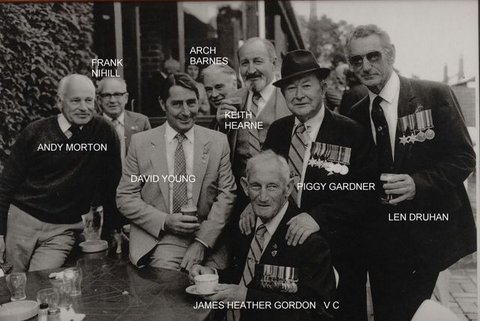Continuing the stories behind the names on the signs at the rest stops on the Remembrance Driveway from Sydney to Canberra.
Jim Gordon
Location of Rest stop:
Sutton Forest
About:
James Gordon, VC (1909 – 1986) was an Australian recipient of the Victoria Cross, the highest and most prestigious award for gallantry in the face of the enemy that can be awarded to British and Commonwealth forces.
Gordon was one of 20 Australians to receive the award for their actions during World War II, receiving it for deeds he performed while fighting against the Vichy French during the Syria-Lebanon campaign.
He later served against the Japanese in the New Guinea campaign and after the war became a soldier in the Australian Regular Army, serving until 1968.
Summary of Victoria Cross award
In June–July 1941, the unit was engaged in the Syria-Lebanon campaign against the Vichy French. During the Battle of Jezzine, on 10 July 1941, Gordon's company was "...held up by intense machine-gun and grenade fire from Vichy French forces, but on his own initiative, he crept forward alone and succeeded in getting close to the machine-gun post. He then charged it and killed the four machine-gunners with his bayonet. His action demoralised the enemy in this sector and the company advanced and took the position." He was subsequently awarded the Victoria Cross for this action.
Citation for the award of Victoria Cross:
On the night of 10 Jul 41, during an attack by “D” Coy on “GREENHILL”, the Coy came under intense M.G. fire and was held up in its advance. Movement by even single individuals seemed almost impossible as in each case when this was attempted that person became a casualty.At this juncture in the effort to advance, Lieut. M.G. Davis and Cpl. POLLARD were killed, Sjt. SMITH, Pte SCOTT and Pte LUFF seriously wounded (Pte Luff dying of wounds after being taken to hospital) The further advance of the two forward pls involved was impossible whilst the enemy M.G. post existed. The enemy position was fortified and completely covered the area on which Pte Gordon, and the remainder of the two pls were located.Pte Gordon, noting the situation, and on his own initiative, crept forward under fire, including grenades, and succeeded in approaching close to the post. He then charged it from the front and with the bayonet killed the four enemy machine gunners. His action completely demoralised the enemy in the area and was a magnificent inspiration to his comrades.The Coy, due to the gallant action of Pte. Gordon was able to advance and took the position. During the remainder of the action that night and the following morning, as on all previous occasions, Pte. Gordon fought with equal gallantry being constantly in close fighting with the enemy. The action of Pte. Gordon is considered worthy of the highest decoration that award of the Victoria Cross is strongly recommended. Recommended. John LararackBrig Comd 25 Aust Inf Bde
Afterwards:
He later served against the Japanese in the New Guinea campaign and after the war became a soldier in the Australian Regular Army, serving until 1968.
On 12 July 1942, a plaque in his honour was unveiled in front of the Gingin Post Office; it was later moved to the town's war memorial. Later that year a portrait of Jim Gordon painted in 1941 by artist William Dargie won the 1942 Archibald Prize, Australia's most famous portrait prize.
Gordon returned to Australia in March 1942 with the rank of corporal. Due to malaria he did not rejoin the 2/31st Battalion in Papua until November 1942. In July 1943, he was promoted to the rank of sergeant. After seeing further action during the capture of Lae and the subsequent advance through the Markham and Ramu Valleys in New Guinea, he returned to Australia in January 1944. He was hospitalised due to malaria again, and was later reassigned to administrative duties. He remained in the Army until 17 February 1947.
After discharge, Gordon briefly worked for the state electricity commission, before rejoining the army as a regular soldier on 2 December 1947, achieving the rank of Warrant Officer Class II in 1950. He continued service until 1 August 1968 when he retired; after this, he was employed at Campbell Barracks (Western Australia), Swanbourne, as a groundsman until 1975.
Gordon died on 19 July 1986 at the Repatriation General Hospital, Hollywood. After being cremated, he received full military honours.
Gallery:
Corporal Jim Gordon VC, 1941
Portrait by William Dargie
Private Gordon posing for the above portrait.
Jim Gordon VC at a Reunion of 2/31 Bn members shortly before he passed away.
Jim and Myrtle Gordon
Warrant Officer James Gordon (left) in New Guinea during WWII.











No comments:
Post a Comment
Note: Only a member of this blog may post a comment.